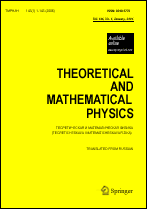|
Geometrical structure of the base and twisting of the graded fibre bundles used in modeling gravitation and elementary particles
V. T. Berezin
Donetsk Physical-Technical Institute, National Academy of Sciences of Ukraine
Abstract:
To deseribe the unification of the fundamental interactions of elementary particles and gravitation the graded bundle mathematical structure $\zeta$ is needed. Its base $B$ is
the 9-dimensional graded space having one scalar, four spinor and four vector dimensions.
One-parametric family of the Poincaré group $1P$ is found. It is shown that any group of this family acts on its invariant subgroup and on the base $B$ in different ways. This situation is
different from the classical one and point out at the nontriviality of the $\zeta$-bundle geometrical properties. The problem of twisting is discussed.
Received: 16.08.1995
Citation:
V. T. Berezin, “Geometrical structure of the base and twisting of the graded fibre bundles used in modeling gravitation and elementary particles”, TMF, 108:1 (1996), 16–35; Theoret. and Math. Phys., 108:1 (1996), 860–875
Linking options:
https://www.mathnet.ru/eng/tmf1174https://doi.org/10.4213/tmf1174 https://www.mathnet.ru/eng/tmf/v108/i1/p16
|


| Statistics & downloads: |
| Abstract page: | 312 | | Full-text PDF : | 185 | | References: | 38 | | First page: | 1 |
|




 Contact us:
Contact us: Terms of Use
Terms of Use
 Registration to the website
Registration to the website Logotypes
Logotypes









 Citation in format
Citation in format 